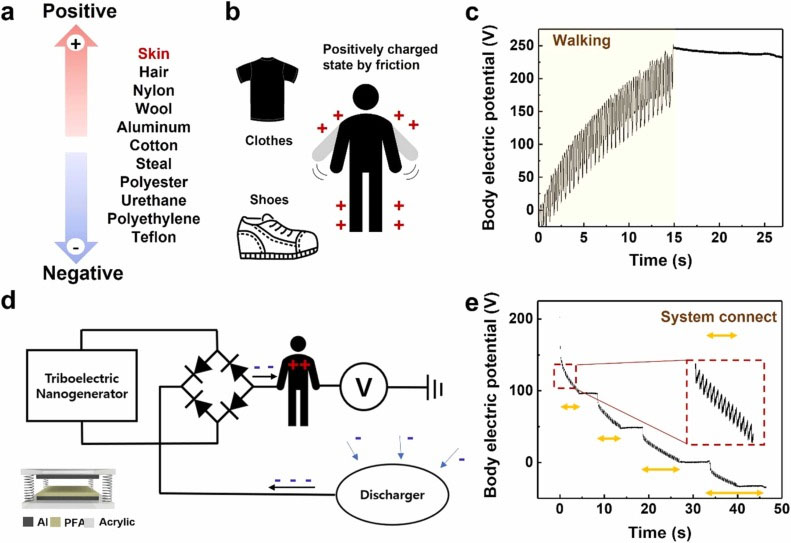| Nov 16, 2022 |
Removing and preventing static electricity using a triboelectric nanogenerator
(Nanowerk News) The research team led by Professor Ju-Hyuck Lee of the Department of Energy Science and Engineering at DGIST (President Yang Kuk) developed a static prevention technology using a triboelectric nanogenerator through collaborative research with Dr. Wanchul Seung of Global Technology Research at Samsung Electronics.
|
|
The findings of this study ("Electrostatic discharge prevention system via body potential control based on a triboelectric nanogenerator") facilitate improved and more efficient static prevention with commercialization potential by expanding the application range of triboelectric nanogenerators.
|
 |
| A technique to decrease the body electric potential using a triboelectric nanogenerator is discovered and developed into a static prevention technology that is easier to apply and more effective than existing static removal methods. (Image: DGIST)
|
|
Recent developments in semiconductors and small electronic components have increased the interest in static prevention, as static damage to small components leads to an increased defect rate.
|
|
Currently, companies use a combination of various anti-static products such as wired grounding wristbands, antistatic mats, shoes, and ionizers. However, these methods result in increased equipment costs and operational inconveniences. Therefore, an efficient and simple static-prevention method is required.
|
|
The research team focused on the cause of static conditions. The human body is generally static owing to the electric potential difference between the body and an object when both come in contact. The cause of this electric potential difference has been found in recent studies on triboelectric series between materials.
|
|
Because the human skin is on the positive (+) side of the triboelectric series, it becomes positively charged (anode) when it contacts typically used objects such as shoes and clothes, sharply increasing the body electric potential to positive (+), causing static. The measurement results of the research team showed that the electric potential of the body increased by more than 100 V after walking for approximately 10 s.
|
|
As a solution, a method for transmitting negative charges to the body was developed. Using a triboelectric nanogenerator, the physical energy generated through body movements, such as walking, can be converted into electrical energy. A rectifier provides a negative charge to the body.
|
|
The team observed that the electric potential of the body decreased to a negative value. The team also confirmed that the rate of decrease in the body electric potential varies based on the output (voltage, current, and charge) of the triboelectric nanogenerator, and the type and surface area of the discharger.
|
|
A static prevention system with an appropriate triboelectric nanogenerator was applied to the sole of the shoe using the aforementioned variables. Consequently, an increase in the electric potential of the body was prevented. This is significantly more efficient than existing wireless antistatic wristbands in the market.
|
|
Professor Ju-Hyuck Lee of the Department of Energy Science and Engineering at DGIST stated, “This study provides a highly cost-efficient method with high-commercialization potential and is expected to effectively prevent static without causing inconvenience to work compared to the existing static prevention equipment.”
|

